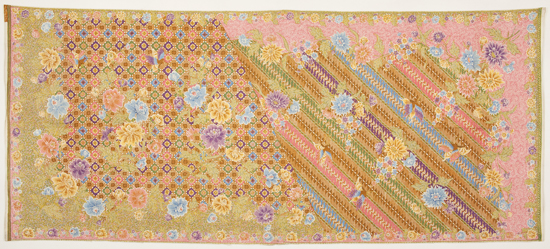Rarely seen Java fabrics on display at Fowler

Textiles such as this 1930s skirt cloth are among the 19th and 20th century batiks on display at the Fowler Museum’s exhibition, “Courtly and Urban Batik from Java.” The diagonal contrasting patterns of this skirt allowed it to be worn two different ways.
By Lauren Roberts
May 23, 2010 10:17 p.m.
Through batik, a painstaking process of hand-drawn wax design and dipping dye, traditional Indonesian cloths are bathed in rich color and patterned with plumes of flora, fauna and abstract design.
These intricate textile adornments are the subject of “Courtly and Urban Batik from Java,” the latest exhibition in a series of rotating installations in the Fowler in Focus gallery at the Fowler Museum at UCLA.
“The technique of using wax to draw on cloth as a resist is a process used across Asia. … The earliest examples can be seen in India, in China, from all these places. We know that the technique is at least 1,000 years old. In Java, the earliest batik textiles we know of are 200 to 300 years old,” said Rebecca Hall, who holds a doctorate in Southeast Asian textiles from UCLA.
On display through Sept. 5, these gems of the Fowler Museum’s permanent Indonesian textile collection are making a rare public appearance.
“We have a vast textile collection, and it doesn’t really get shown that much, so it’s a good opportunity to see these amazing things that we have that never see the light,” said Sebastian Clough, the Fowler Museum’s exhibition designer.
Showcasing two distinct regional styles, the exhibit features 11 Java batiks dating from the mid-19th to mid-20th century. Diverse selections range from the courtly textiles of central Java sultanate royalty to the batik of urban coastal workshops, with uses ranging from shrouds to skirt cloths.
“(Batik is) something that’s associated with palaces or when people have a lot of free time to do it, because it is so time-consuming to produce. If you’re a sultan, you have people to do it for you. That’s not always the case if you’re a working farmer,” Hall said.
Distinguished by their traditional use of earth tones of cream, brown and blue-black, central Java batiks on display include ceremonial skirt cloths, meant for the elite of Javanese court society.
Meanwhile the workshop-produced batik from Java’s north coast commonly features more color variety, with floral patterns in pink, orange, yellow and violet, as well as a wider range of motifs due to coastal foreign influences.
These diverse cultural influences are reflected in the textiles of coastal Java, which had access to international trading ports. Chinese, Eurasian (typically mixed Dutch and Javanese ancestry) and even Arab-Indonesians operated batik workshops.
Foreign influence is reflected in a 19th century Islamic batik banner inscribed with Arabic calligraphy and believed to have once hung in a Sumatran marketplace. The red, white and blue batik is adorned with the double-bladed sword of Muhammad, a design rarely seen in batik textile.
“The designs are stunning in their detailing,” said Veronica Morones, a third-year geography and environmental studies student and a Fowler Museum attendant.
Though the batiks maintain their saturated vibrancy, the textiles are delicate in their age. Propped on slanted display boards, each batik is carefully displayed.
“With textiles, there’s always a number of ways to display them. You can drape them, but we use (slant boards) because they help the cloth relax. If it was (displayed vertically), it would stress the cloth out,” Clough said.
Preservation is crucial for such rare examples of the traditional Southeast Asian art practice.
“In a place like Java, which is so humid and hot, batik doesn’t necessarily age well. That’s one of the problems with why we only have examples going back a couple hundred years,” Hall said.
The Fowler Museum’s exhibit offers an intimate look at a detailed art form not commonly displayed.
“You realize how much detailed work can go into a fabric,” Hall said. “We associate a lot of times painting on things that are objects ““ paintings or drawings (on canvas and paper). Often textiles take much longer (to produce). It’s nice to see that production changes over time, style changes over time, and it’s nice to get to see it all in one place to compare.”


